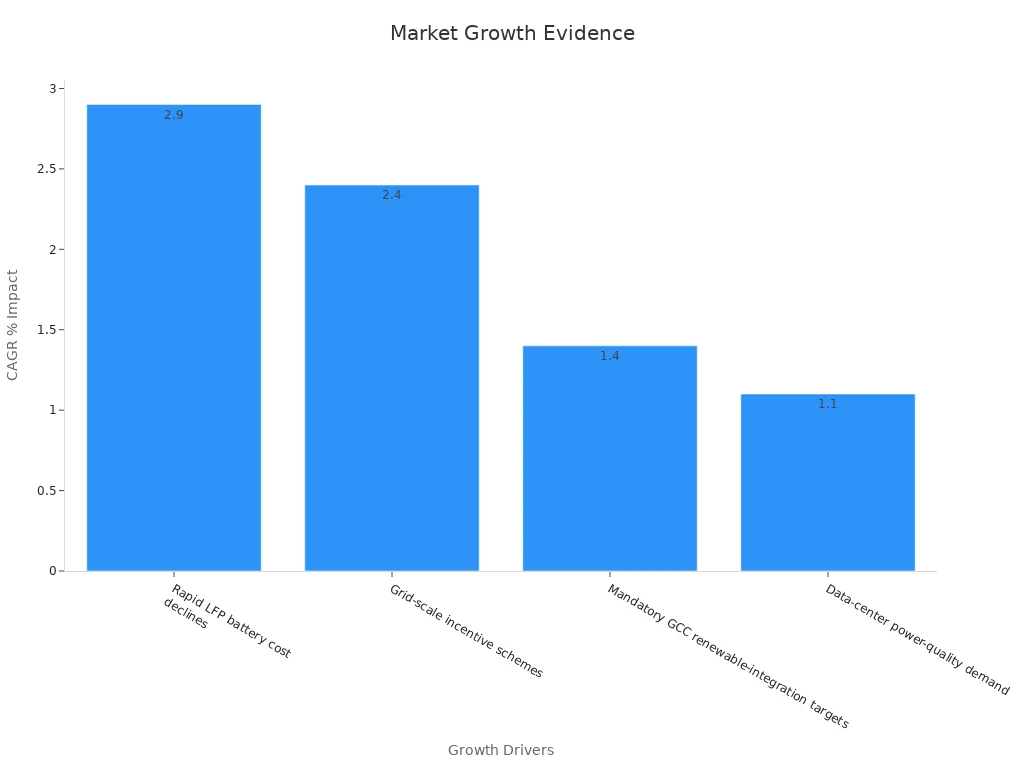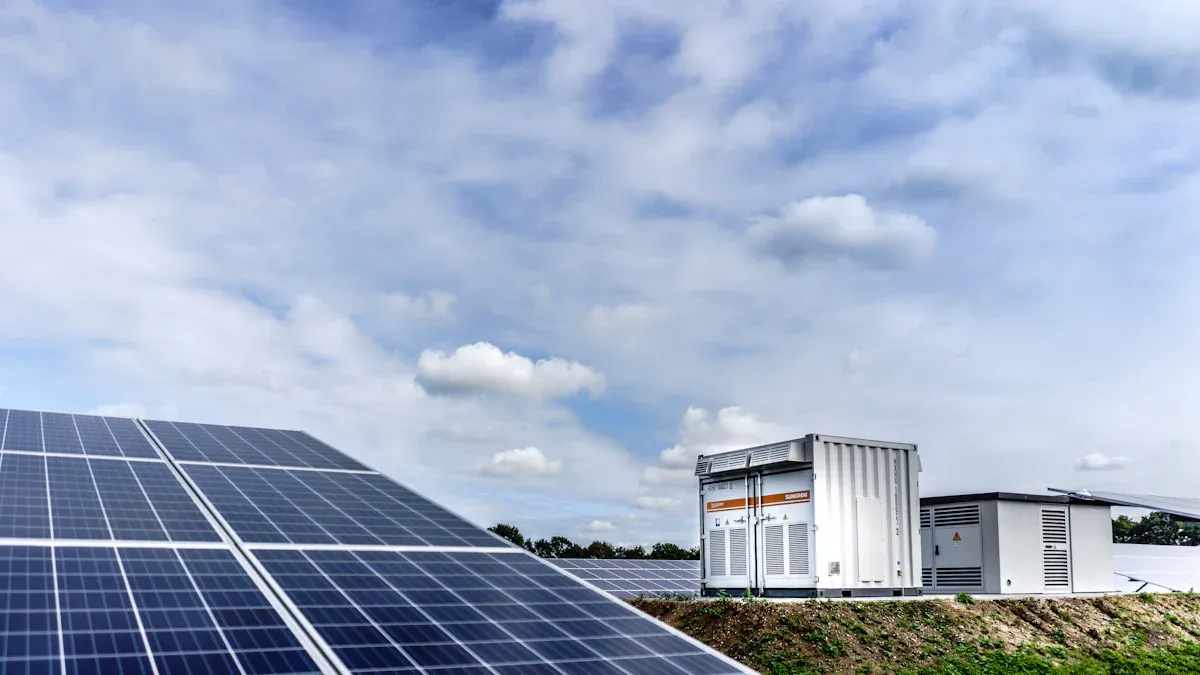Why is this important? Solar and wind energy are great, but they don’t work all the time. Energy storage fills this gap, giving us steady and reliable power. No wonder the energy storage market is growing fast!
Key Takeaways
Energy storage systems work like big batteries for the power grid. They save extra energy and give it back when needed. This keeps power steady and reliable.
There are different types of energy storage, like batteries, heat storage, and machines. Each type has special uses for homes and businesses.
Energy storage makes solar and wind power more dependable. It also helps us use less oil and gas.
Using energy storage can save money. It lets people use cheaper energy at night and gives backup power during blackouts.
Understanding Energy Storage Systems
How Energy Storage Systems Work
These systems make power more reliable and cost-effective. For example, they store cheap energy at night and release it during busy hours. This keeps costs low and power steady.
Fun Fact: Some storage systems last longer than lithium-ion batteries. Options like thermal or chemical storage are better for long-term use. They’re also affordable, making them great for clean energy plans.
Key Components of Energy Storage Systems
Every energy storage system has parts that help it work well. Here’s what they include:
Storage Medium: This holds the energy, like a battery or thermal tank.
Power Conversion System: It changes energy into storable forms and back again.
Control System: It manages when energy is saved or released.
Monitoring System: It checks how the system is working to improve efficiency.
These improvements make energy storage more reliable and efficient.
Energy storage is also important for renewable energy. A study showed that meeting 85% of electricity needs with solar and wind requires 12 hours of storage (162.74 GWh). To cover the last 15%, 10,090 GWh is needed. This proves how vital energy storage is for clean energy systems.
Types of Energy Storage Technologies

Energy storage comes in different types, each with special uses. Let’s look at three main kinds shaping the energy future.
Battery Energy Storage Systems
Batteries are the most common way to store energy. They keep electricity as chemical energy and release it when needed. You’ve seen batteries in phones or remotes. Now, imagine them much bigger!
As shown, battery systems are affordable and efficient, making them a top choice.
Did you know? The battery market is growing fast! By 2024, it may reach $49 billion, growing 16.5% yearly until 2030. This is thanks to cheaper lithium iron phosphate (LFP) batteries, costing under $115 per kWh.

Thermal Energy Storage
Thermal storage works differently. It keeps heat or cold instead of electricity. This energy is later used for heating, cooling, or making electricity. Think of it as a big thermos that saves energy until needed.
One method is molten salt storage. It heats salt to high temperatures to save energy. When needed, the heat makes steam, which powers a turbine to create electricity. Thermal storage is great for big places like power plants or factories.
Though less common than batteries, thermal systems are reliable for long-term use. They also cost less in some setups, as shown in the table above.
Tip: Thermal storage is perfect for areas needing lots of heating or cooling. It’s an efficient way to store energy without batteries.
Mechanical Energy Storage
Mechanical storage uses movement to save and release energy. Pumped hydro storage is a well-known example. It pumps water uphill when there’s extra energy. Later, the water flows down through turbines to make electricity.
Other types include flywheels and compressed air systems. Flywheels store energy by spinning fast, while compressed air systems save energy by squeezing air into underground spaces.
Mechanical systems last a long time and are great for large-scale storage. They work best in places with the right geography for pumped hydro.
Fun Fact: Pumped hydro storage makes up over 90% of the world’s energy storage. It’s been used for more than 100 years!
New Energy Storage Technologies
Energy storage is changing quickly with amazing new ideas. These new technologies are helping us store energy in smarter ways. They go beyond regular batteries and aim for a cleaner future.
Flow Batteries: Big Storage Made Easy
Flow batteries are different from normal ones. They use liquid instead of solid materials to store energy. The liquid moves through the system, making it easy to store large amounts of energy. These batteries last longer than lithium-ion ones and work well with solar and wind power.
Fun Fact: Flow batteries can work for 20 years with little upkeep. That’s great for long-term energy needs!
Hydrogen Storage: Clean Energy in a Gas
Hydrogen is another cool way to store energy. Extra electricity splits water into hydrogen and oxygen using electrolysis. The hydrogen is saved and later used to make power or fuel vehicles. It’s clean, flexible, and very useful.
Hydrogen storage is great for factories and transportation. Imagine cars running on hydrogen instead of gas. This could change how we travel and use energy.
Solid-State Batteries: A Safer Option
Solid-state batteries are a new type of battery. They use a solid material instead of liquid to store energy. This makes them safer and able to hold more power. They’re still being developed but may soon be in cars and phones.
Tip: Solid-state batteries charge faster and last longer. They could be the future of energy storage.
Gravity Storage: Using Weight for Power
Gravity storage uses heavy objects to save energy. Extra electricity lifts weights. When energy is needed, the weights are lowered to create power. It’s a smart way to use gravity for storing energy.
This method is eco-friendly and doesn’t need rare materials. It’s perfect for places without other storage options.
Supercapacitors: Quick Energy Bursts
Supercapacitors store small energy amounts but release it fast. They’re great for short power needs, like helping the grid or powering buses. They don’t replace batteries but work well with them.
Did you know? Supercapacitors charge in seconds and last millions of cycles. They’re fast and durable!
These new technologies are changing how we store energy. They’re making storage better, cleaner, and cheaper. As they improve, they’ll help power our world in exciting ways.
Benefits of Energy Storage Systems
Grid Stability and Reliability
Energy storage systems help keep the electric grid steady. They handle sudden changes in energy supply or demand easily. These systems act like a backup, stepping in when solar or wind power isn’t steady.
For example, adding 10 GW of storage to areas with lots of renewable energy makes grids more stable. It lowers costs and supports grid flexibility, reducing blackouts and improving energy flow.
Fun Fact: Energy storage reacts in milliseconds to balance the grid during busy times.
Renewable Energy Integration
Energy storage makes renewable energy more useful. Solar panels and wind turbines don’t always make power when needed. Storage systems save extra energy and release it later.
Imagine your solar panels making too much energy on a sunny day. Instead of wasting it, storage saves it for nighttime use. This helps reduce fossil fuel use and supports clean energy.
Tip: Using batteries with solar or wind systems boosts efficiency and lowers pollution.
Cost Savings and Efficiency
Energy storage saves money by using cheaper energy during off-peak hours. It releases stored energy during expensive peak times. Both businesses and homes can save money this way.
Here’s how energy storage cuts costs in different places:
Scenario | Daily Savings | Annual Savings |
|---|---|---|
EV Charging Station (California) | $125 | $45,625 |
Remote Mining Site (Australia) | $1,500 | $547,500 |
Utility Voltage Support (Texas) | N/A | $5,000 |
These examples show how storage systems save money and improve efficiency. They’re great for homes and businesses alike.
Did you know? Lithium-ion batteries are getting cheaper, making storage systems more affordable for everyone.
Decentralized Energy Systems
Imagine making and using your own energy. That’s what decentralized energy systems do. Instead of depending on a big power grid, you can create, store, and use energy nearby. These systems are showing up everywhere, like homes with solar panels or towns using wind turbines. They’re changing how energy works.
Why Decentralized Energy Matters
Decentralized systems give you freedom. You don’t need to worry about blackouts or high bills. They also help the planet. Using renewable energy like solar or wind lowers pollution and saves resources.
🌱 Tip: Decentralized systems are great for faraway places. They bring power where the main grid can’t reach.
Key Benefits of Decentralized Energy
Here’s why people love decentralized energy systems:
Energy Independence: Make your own power and avoid grid problems.
Cost Savings: Local energy can cut your electricity costs.
Environmental Impact: Renewables reduce harmful emissions.
Flexibility: Build systems for one house or a whole community.
Real-World Examples
Microgrids are small grids that work alone using local energy. They’re perfect for schools, hospitals, or neighborhoods. Rooftop solar panels are another example. They let you use sunlight to power your home.
⚡ Fun Fact: In 2022, over 50 million homes used decentralized systems. This number is growing quickly!
Decentralized energy systems are helping create a cleaner and more reliable future. They let people control their energy while protecting the environment.
Applications of Energy Storage Systems

Energy storage systems are changing how we use energy. Let’s look at their main uses and how they help the future.
Residential and Commercial Applications
Imagine using stored energy to power your home or business. Energy storage systems make this possible. Homes can pair these systems with solar panels. They save extra energy during the day and use it at night. This lowers electricity bills. Businesses also benefit by using stored energy during busy hours. This avoids high costs and keeps things running smoothly.
These systems also provide backup power during outages. Whether it’s a storm or grid failure, you’ll have energy when needed. They also help the planet by using more renewable energy. It’s good for your wallet and the Earth.
Utility-Scale Energy Storage
Utility-scale systems handle large amounts of energy for grids. They keep the grid steady and reliable. These systems have big advantages:
Grid Stability: They quickly balance energy supply and demand.
Demand Management: They store energy during quiet times and release it later.
Integration of Renewables: They smooth out changes in solar and wind energy.
For example, a battery system can save energy from a wind farm at night. It releases this energy during the day when people need it more. This reduces fossil fuel use and ensures steady power. Utility-scale systems are key for cleaner energy.
Transportation and Electric Vehicles
Energy storage is changing transportation, especially with electric vehicles (EVs). EV batteries store energy to power cars. They are light, efficient, and give long driving ranges. As batteries improve, EVs are becoming cheaper and easier to use.
Public transportation benefits too. Electric buses and trains use stored energy to lower emissions and costs. Even airplanes are testing battery-powered designs for short trips. Energy storage also helps EV charging stations. These stations save energy during quiet times and use it for fast charging later.
Energy storage in transportation is making travel cleaner and greener. Whether it’s a daily drive or a long trip, these systems make sustainable travel possible.
Industrial and Remote Applications
Energy storage systems are changing how industries and remote areas use power. Let’s see how they help in these places.
In factories, energy storage manages power during busy times. Machines need lots of electricity when running at full speed. Energy can be saved during quiet hours and used later. This lowers costs and keeps work running smoothly. It also prevents stops during power outages.
Remote areas have special problems. Many don’t connect to the main power grid. Energy storage fixes this by working with solar panels or wind turbines. For example, a village can use solar power in the day and stored energy at night. This gives steady and clean power.
Mining sites are another example. These places are often far from cities. Energy storage gives them steady power, cutting the need for diesel. This saves money and reduces pollution.
🌟 Tip: Energy storage is great for places without reliable grid power. It ensures you always have electricity when needed.
Here’s a simple table showing the benefits:
Use Case | Benefit | Example |
|---|---|---|
Factories | Save money on energy | Use during peak hours |
Remote Villages | Reliable and clean power | Solar + storage systems |
Mining Sites | Less diesel, less pollution | Cheaper, cleaner energy |
Energy storage is helping industries and remote areas get better power. It makes energy more steady, affordable, and eco-friendly.
Challenges and Limitations
Energy storage systems are changing energy use, but they face problems. Let’s look at the main issues stopping them from spreading everywhere.
Economic Barriers
Money is a big problem for energy storage systems. Building and keeping these systems running costs a lot. Large setups, like batteries, need special materials and tools. This makes them pricey for small businesses or towns.
Some people in the industry don’t want to use energy storage. They worry about high costs or if it will help long-term. Rules and laws also slow things down. These make it harder to add storage systems to the power grid.
Here’s a simple table of economic problems:
Problem Type | What It Means |
|---|---|
Money Issues | High costs stop people from using storage |
Industry Resistance | Some groups don’t trust storage systems |
Rules and Laws | Policies make adding storage harder |
To fix these problems, we need better funding and helpful rules.
Technological Challenges
Energy storage is getting better, but it still has limits. Batteries need rare materials like lithium, which are hard to find and bad for nature. Getting these materials depends on global trade, which can be risky.
Handling energy demand is tricky. Solar and wind power change a lot, so storage systems must adjust. Old power grids weren’t made for storage, making it hard to add these systems.
Main technology problems include:
Storage systems need to be more reliable.
Renewable energy changes too much to store easily.
Batteries depend on rare materials like lithium.
Global trade issues can hurt material supply.
Old grids make scaling storage difficult.
These problems show why new ideas are needed to make storage better.
Environmental Concerns
Energy storage helps clean energy, but it’s not perfect. Mining for battery materials like lithium can hurt nature and water. Making batteries also creates waste and pollution, which isn’t great for the planet.
Old batteries are another issue. They don’t last forever, and throwing them away can cause toxic waste. Recycling is improving, but it’s not common enough yet.
To help the environment, we can use systems with safer materials. Long-term options like hydrogen storage are also better for nature. These choices avoid harmful mining and support cleaner energy.
Energy storage is important for a green future, but fixing these environmental problems is key to making it truly eco-friendly.
Policy and Regulatory Issues
Energy storage systems are helpful, but rules can slow them down. Policies decide how storage connects to the grid and who pays for it. Without clear rules, it’s hard for storage to expand.
Old rules are a big problem. Many grids were made before storage was common. These grids don’t always work with new technology. For example, some places don’t let storage send energy back to the grid. This limits how useful stored energy can be.
Another issue is cost-sharing. Who should pay for storage upgrades—governments, companies, or people? Without fair rules, costs can become too high for many. This makes it harder for people to start using storage.
Rules also affect renewable energy. Storage helps solar and wind power work better. But some policies still favor fossil fuels. This makes it tough for clean energy to grow.
What can fix this? Governments need to update rules to support storage. They should make it easier to connect storage to the grid. Tax breaks or rebates can also help lower costs. These changes would encourage more people to use storage.
🌟 Tip: Check local rules if you’re thinking about energy storage. Some places offer great deals for homes and businesses.
Better policies can help storage systems grow. They’ll make energy cheaper, grids stronger, and renewables more dependable.
Energy storage systems are changing how we use and store energy. They help match renewable energy with demand, keeping power steady and reliable. New ideas like long-lasting storage and solid-state batteries make clean energy more possible. More money and teamwork will improve these systems, making energy greener and easier to get. Picture a world where clean energy powers everything—that’s the future we’re working toward. The path to clean energy has never been more exciting!
🌟 Note: As renewable energy grows, energy storage systems will help balance grids and cut pollution.
Evidence | Description |
|---|---|
Long-lasting storage options | Important for keeping energy steady when renewables don’t produce enough. |
Bigger role in clean energy | Advanced storage will be key as renewables grow for stable energy supply. |
Funding and teamwork | Investments and global teamwork are needed to solve problems and improve. |
FAQ
What do energy storage systems do?
Energy storage systems keep extra energy and use it later. They make sure power is steady by balancing supply and demand. These systems store renewable energy, like solar or wind, for times when the sun isn’t shining or the wind isn’t blowing.
How do energy storage systems help renewable energy?
They save extra energy from renewables during busy production times. Later, they release this energy when demand is high or production slows. This makes renewable energy more reliable and reduces the need for fossil fuels. Think of them as a link between making and using energy.
Are energy storage systems costly to set up?
The price depends on the system’s type and size. While starting costs can be high, they save money over time by lowering energy bills and avoiding peak charges. Falling battery prices and government programs make them cheaper for homes and businesses.
Can energy storage systems work in faraway places?
Yes! They work well with solar panels or wind turbines to give steady power in areas far from the grid. For example, a village can use stored solar energy at night. This cuts the need for diesel generators and lowers pollution.
How long do energy storage systems last?
It depends on the kind of system. Lithium-ion batteries last about 10-15 years. Flow batteries and mechanical systems can last even longer. Regular care helps them last longer. Some systems, like hydrogen storage, are great for long-term energy needs.

